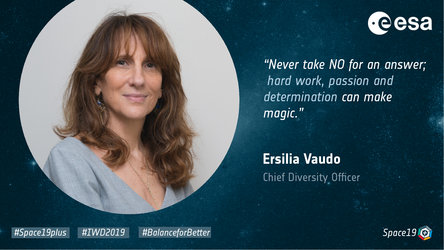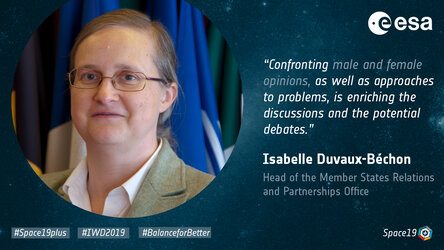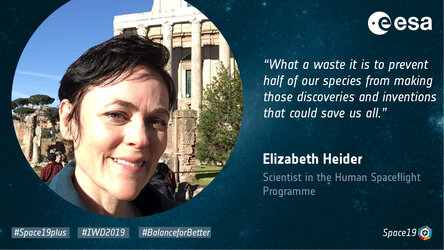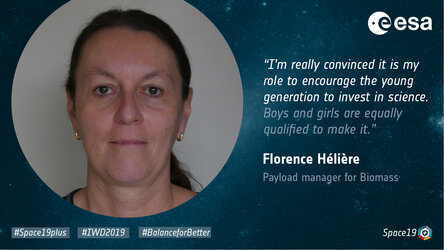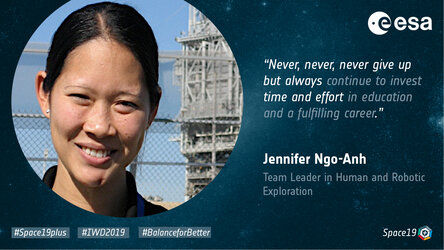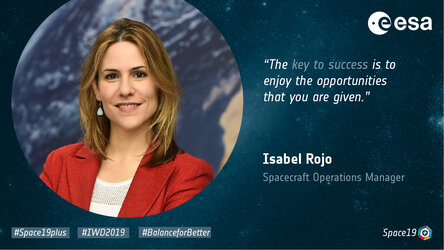Valerie Fernandez, ESA Payload Manager for Sentinel-2
Please give a brief description of your duties at ESA.
Working in the space business for 20 years, I am payload manager for an Earth observation mission, part of the Copernicus programme, Sentinel-2. I am also study manager for a future mission, called C02M. The two positions combine technical and management tasks very well. The former has a high-pressure schedule to get hardware on time in order to achieve full instrument integration and tests prior to final mounting onto the platform. The latter is concentrated on technical trade-offs to get the best satellite architecture fitting the performance. For these two projects, which are not in the same development phase, I have the chance to lead two groups of highly skilled engineers and am enjoying the motivation.
What inspired you to pursue a career in science and engineering and what motivated you to join ESA specifically?
Being a solution-oriented woman, I was very interested in our world and its physical principles with the objective to find ways to improve our daily life. After a master’s in engineering sciences (signal theory), I had the opportunity to do a PhD in remote sensing and data calibration. This was my first step in space! Since then, I have worked on building satellites motivated by the idea that we have to develop the best instruments to understand how our beautiful planet can be preserved. I started from the industrial side, following technical requirements by ESA, with the idea that I could contribute even more if I understood how the requirements are derived from the scientific and users’ needs. Joining ESA was a natural move in order to help develop Earth Observation missions by defining the space segment’s boundary conditions with the various stakeholders (delegations, industry, scientists, etc.).
Did you encounter gender barriers on your way to becoming a scientist / engineer?
Well, it is always difficult to say that we face “gender barriers”. When we are in an environment where only 10–15% are women, it is a natural barrier that you have. You experience this barrier mainly by the behaviour around you. The good thing is that we know it is there! Being an easy-talker and curious by nature, I feel comfortable with diverse points of view and value this as an asset. But it is true that I had to adapt a lot when I was a young engineer in industry. With senior or experienced engineers, I often had to listen at great length before being able to express my ideas whereas this was not the case for young male colleagues. There was also a sort of common understanding between men, which meant that I had to justify my position with more argument. I have gained from this experience since it has increased my ability to better understand others.
What progress have you seen in addressing the gender imbalance in your profession through equal-opportunity measures in recent years?
When I started in 1998, career progression for women was more complex and slowed down by maternity leave. You had to think about the evolution of your job position as well as the expectations of your private life. For example, when a contract for satellite development was won, it was better to avoid any absence from work in order to have the best chance to be part of the project team. Nowadays, this has evolved in industry; there is increasing recognition from upper management that a balanced life is needed to get the best efficiency at work. Gender policies are also being put in place, which allow women to get promoted to decision-making positions.
What are, in your view, three measures that could make a difference in supporting a work–life balance and at the same time equal career opportunities.
To have more equal career opportunities, you first need women who are ready for such job positions. In engineering, we still lack an abundance of young women. The recruitment would be easier if there were more applicants, meaning more women studying in this domain. It is important to participate in future career fairs, promoting open days, and so on.
The advertisements to attract more women in space jobs should emphasise the soft skills required by management and leadership positions, for example. Women greatly value the personal development gained during their professional life. A workplace that supports diversity and builds confidence – both internally to support your group and externally with your industrial partners to achieve complex but common goals – may be as important as the results and challenges faced.
Work-life balance measures are more complex to identify as they are applicable to all. It is also subject to perception: some consider part-time/teleworking as the best way to be efficient (high confidence and independence) and others consider it a path to becoming isolated/forgotten. I believe that an important part of work-life balance is to have a shared understanding of the work to be done with a comprehensive workload shared between team members. “A feel good” at work related to “a feel good” in the role you have, with tasks contributing to the achievement of the group’s objectives. A shared confidence will exist within the group if people know that the group counts on you. This is a link that will create individual opportunity for recognition and career evolution.
What advice would you give to a girl or young woman who is considering a career in science and engineering?
Keep your dreams alive! Be confident in yourself. Different views, different approaches and different opinions are highly valued in professional life.



